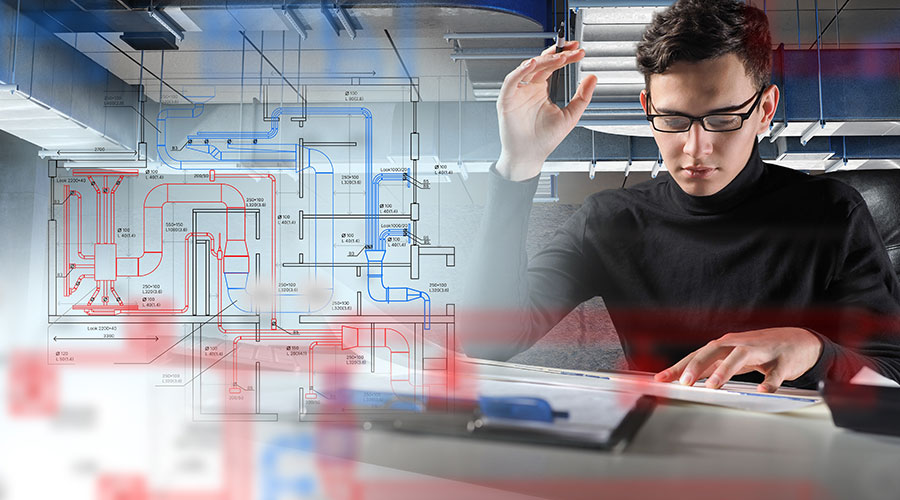Understanding What an Energy Model Can and Can't do is Critical to its Success
With rising gasoline and other fuel prices in recent years, energy efficiency has been at the top of many facility managers' minds. To address the need for energy efficiency, the number of state and nationwide energy-saving programs, mandates and incentives has increased dramatically. These include increasingly stringent energy codes and standards, green building rating systems, federal tax deductions, numerous state- or utility-specific rebates and incentives, and building labeling programs, to name a few.
All of these highlight the importance of quality energy modeling early during the design phase, ideally as a part of an integrated design process. An energy model is primarily a decision-making tool for comparing various scenarios in a building design to help achieve energy and cost savings.
The term "integrated design process" is thrown about frequently in the design and construction industry these days, with its supporters touting the benefits of early stage collaboration among various stake-holders including facility managers, owners, architects, engineers and contractors. During these conversations, proponents will likely bring up energy modeling as a key ingredient in the integrated design process, but may not be able to fully articulate the benefits that energy modeling can provide. On the other hand, they may over-promise what energy models can actually do for the owner.
Initial Analysis
Although architects have the primary ability and skills to visually represent multiple building designs at an early stage of design or conceptualization, an energy analyst is best suited to illustrating multiple paths to achieving the owner's energy saving goals. Therefore, an effective integrated design process should include the input of the energy analyst during this conceptual design phase. Just as an architect can provide a visual comparison of a brick veneer vs. a curtainwall assembly, an energy analyst can provide a "high-altitude" view of design strategies that affect energy consumption. Ideally, this effort analyzes strategies that are difficult to change later in the design process, such as building orientation, shape, programming, shading and window-to-wall ratio. The purpose is to help drive decisions towards the owner's goals for the building.
The process is dependent on the owner's energy-saving goals for the building. As a result, goal-setting should be a topic of discussion early in the design process, ideally during the project kick-off meeting or an eco-charrette. Energy goals could include one or more of the following:
- Comparative, such as achieving a design that consumes 30 percent less energy than an ASHRAE 90.1 baseline building
- Absolute, such as achieving a design with an energy use intensity (EUI) of 40 kBtu per square foot per year
- Certification-based, such as achieving an Energy Star Label or LEED certification
- End-use specific, such as designing a building where all domestic hot water is provided by solar thermal water heaters.
Compare and Contrast
As the design progresses and more key decisions have to be made, the energy model can be used to identify synergies in the design that can help to bring down projected energy costs in a number of ways.
1. Identifying synergies to reduce equipment sizes. To reduce energy consumption, it is not only necessary to invest in energy modeling at an early stage, but it may also be necessary to invest more money in particular building components like high-efficiency ground-source heat pumps or variable refrigerant flow systems. However, that doesn't mean that the overall building costs have to be appreciably higher. Modeling various building shapes and exterior shading devices can result in an optimized passive solar design that reduces the solar heat gain on the building in the summer and allows the sun to heat the building in the winter when the sun is generally lower in the sky.
Additionally, modeling various window-to-wall ratios and glazing selections can identify an optimized design for daylight harvesting that minimizes solar heat gain while allowing enough visible light into the occupied spaces to maintain acceptable light levels. This in turn allows the electric lights to dim or turn off completely. As a result of the passive solar design and reducing lighting loads during the peak times of day, HVAC equipment capacities can be reduced, saving first costs.
This is a perfect example of the integrated design process in action, where the synergy of architectural design, lighting design, and mechanical systems design can produce a solution that reduces operating costs and yet may not increase first costs compared to a typical, non-integrated design approach. And though general principles toward passive design and daylighting may provide a "good" solution, energy modeling is the best tool around for getting a "great" solution.
2. Find areas of highest potential impact. Comparisons of various "what-if" scenarios in a building show that some energy conservation measures eventually have diminishing returns. As a result, an energy model can be used to show how a project's budget can be allocated most cost-effectively to meet the project's energy goals.
For example, a process called "load elimination" can be used as a way to show the relative impact that different building components have on energy consumption. A first step may be incrementally increasing wall insulation from code-minimum values to some maximum value where wall heat transfer is essentially eliminated.
It's also possible to do a similar analysis for interior lighting power, process loads, window U-value and ventilation. This analysis may show that adding insulation may not decrease energy consumption as much as reducing lighting power by 25 percent. And while many would agree that optimizing passive elements of the building such as the building envelope and shading are important and should be the first areas to be examined, there is a point of diminishing returns in making improvements to some elements. At some point, it may be more cost-effective to look elsewhere to meet the owner's energy goals.
Along these same lines, energy modeling can show which areas of the building design might hold the biggest opportunities for improvement. For example, a preliminary energy model for a building may show that 90 percent of the building energy consumption is used by electricity and only 10 percent is used by natural gas. This suggests that the first place to search for energy-saving opportunities might be in the electricity-using end-uses. Investigating the individual electrical end-uses in the model may show that 50 percent of the electricity is currently modeled as being used by lighting, while the rest is evenly used by plug loads, fans and cooling equipment. Knowing from previous experience that lighting typically doesn't consume such a high portion of the electricity may indicate that the best place to start the search for energy saving opportunities might be the lighting design.
3. Identifying counter-intuitive building performance relationships. As the need for increased energy efficiency may require more complex and integrated relationships among buildings and their mechanical and electrical systems, conventional wisdom may not hold as true. For example, energy standards of late have been incrementally increasing the minimum requirements for insulation in the building envelope, so design teams might be tempted to conclude, "If a little is good, a lot must be better."
Some buildings, such as hospitals and heavy manufacturing facilities, do not always benefit from exceeding the minimum insulation requirements. An analysis of the energy model output sometimes shows that the internal loads of the building (people, lighting and process loads) tend to dominate the external loads exerted by outside air temperature and solar heat gain. As a result, these process-intensive buildings are penalized by a highly-insulated envelope that does not allow internal loads to radiate out of the building.
Related Topics:












